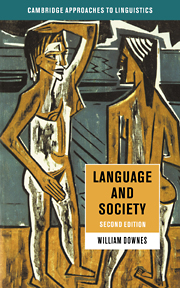Book contents
- Frontmatter
- Contents
- Acknowledgements
- 1 Linguistics and sociolinguistics
- 2 A tapestry in space and time
- 3 Language varieties: processes and problems
- 4 Discovering the structure in variation
- 5 Rhoticity
- 6 At the intersection of social factors
- 7 Change, meaning and acts of identity
- 8 The discourse of social life
- 9 Communication: words and world
- 10 Action and critique
- 11 Language and social explanation
- Further reading
- References
- Index
10 - Action and critique
Published online by Cambridge University Press: 05 June 2012
- Frontmatter
- Contents
- Acknowledgements
- 1 Linguistics and sociolinguistics
- 2 A tapestry in space and time
- 3 Language varieties: processes and problems
- 4 Discovering the structure in variation
- 5 Rhoticity
- 6 At the intersection of social factors
- 7 Change, meaning and acts of identity
- 8 The discourse of social life
- 9 Communication: words and world
- 10 Action and critique
- 11 Language and social explanation
- Further reading
- References
- Index
Summary
The consideration of linguistic uses associated with any practical pursuit, leads us to the conclusion that language … ought to be regarded and studied against the background of human activities and as a mode of human behaviour in practical matters … language functions as a link in concerted human activity, as a piece of human behaviour. It is a mode of action and not an instrument of reflection.
Malinowski (1923)Action and intention
One theme of the last several chapters has been that to utter, or produce any linguistic token, is to do something. In Malinowski's words, it is ‘a mode of action’. In considering the prayer in chapter eight we claimed that the text was an activity. We argued that the words ‘we pray thee’ performed the act of entreating or performing a humble request. It has been a fundamental assumption of pragmatics that utterances are a form of human action (Levinson, 1983: 226). To say something is similar to performing many other types of actions; for example, opening a window, mailing a letter, hitting a ball with a cricket bat, beckoning to someone, and so on. Speech acts have their own particular characteristics but also share certain important properties with other types of non-verbal action.
Let us examine two such properties. The first property was described by the philosopher G. E. M. Anscombe in her book Intention (1957).
- Type
- Chapter
- Information
- Language and Society , pp. 368 - 414Publisher: Cambridge University PressPrint publication year: 1998



